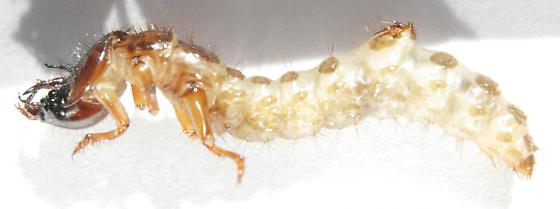Circle of Life
Reproduction
Omus californicus, commonly referred to as
the California Night-stalking Tiger Beetle, is a nocturnal
organism with four known classified subspecies (Pearson and
Vogler 2001, Pearson et al. 2005). Once at adulthood, the
California Night-stalking Tiger Beetle females can then
reproduce and mate with males. To initiate copulation between a
female and a male, the male approaches the female until close
enough to lunge onto the female’s back (Shivashankar and Pearson
1994). Once on the back of the female, the male attaches to the
female by a firm grasp on her thorax with his mandibles and
front legs, while the hind legs remain on the ground to allow
dual movement between the two tiger beetles (Shivashankar and
Pearson 1994). During copulation, the male will grasp the female
and ride atop her back during a period known as amplexus and may
still continue to ride the female after this process for a short
period (Shivashankar and Pearson 1994).

Following copulation, the female searches for and creates a
burrow location which mostly consists of clay sediment (Kinsley
and Julian 1988, Pearson and Vogler 2001, Pearson et al. 2005).
The female commonly examines the soil through the senses of
touch and taste. By use of the antennas, the female will gently
touch the soil, and might also grasp a few grains of soil to
determine if the texture of the sediment will be the best available soil conditions
for the egg (Brust et al.
2012, Kinsley and Julian 1988). California Redwood tree paths
provide a safe location to the, often clumped, burrows
(Pearson et al. 2005). Upon finding a suitable place to create a
burrow, the female Omus californicus will begin to dig into the
soil removing the sediment by use of the gonapophyses, which
allows the Tiger Beetle to move the soil to the side and create
a deeper burrow (Brust et al. 2012). Once complete, the burrow
ranges between six and nine millimeters in length and between
twenty-five to thirty centimeters in depth (Kinsley and Haines
2010). The female will then deposit a single egg which is two to
four millimeters in length into the hole of the burrow and
refills the opening with the disturbed sediment from the
formation of the burrow to protect the egg (Han son 1998, Burst
et al. 2012).
son 1998, Burst
et al. 2012).
Growth and Development
Omus californicus typically lives 3 years and matures through three different instars, or growth phases, during the larval development: the first instar, the second instar, and the third instar which attributes to most of their life span (Pearson et al. 2005, Kinsley and Julian 1988). The egg typically hatches within two to four weeks, upon which the California Night-stalking Tiger Beetle enters the larval stage of development (Hanson 1998). The maturation of the larvae depends on abiotic factors such as temperature (Burst et al. 2012), while the maturation time depends heavily on food availability; therefore the larval survival rate increases corresponding to an increase in food availability (Burst et al. 2012, Kinsley and Julian 1988). The first instar lasts a few weeks while the second instar of development occurs between one to a few months (Kinsley and Julian 1988). The final instar of maturation happens from six months to a year (Kinsley and Julian 1988). The larvae of Omus californicus is highly similar to other species and other genuses of Tiger Beetles (Pearson and Vogler 2001). The larvae have a white cream coloration covering the developing organism, with large hooks at the bottom mid-rear to help anchor themselves when catching prey; the large head is capped with a black plate and on the abdominal hump there are three paired spines (Pearson and Vogler 2001, Hansan 1998). The carnivorous larvae then gather food by burrowing a unique tunnel to the surface of the soil to attack prey by quickly grasping passing organisms and dragging the organism back into the burrow (Pearson and Vogler 2001, Burst et al. 2012, Kinsley and Juliann 1988). Once reaching adulthood, Omus californicus is highly agile and quick, active primarily from May to June. (Spomer et al. 2008, Pearson et al. 2005).
Page Created by Alex Marquardt